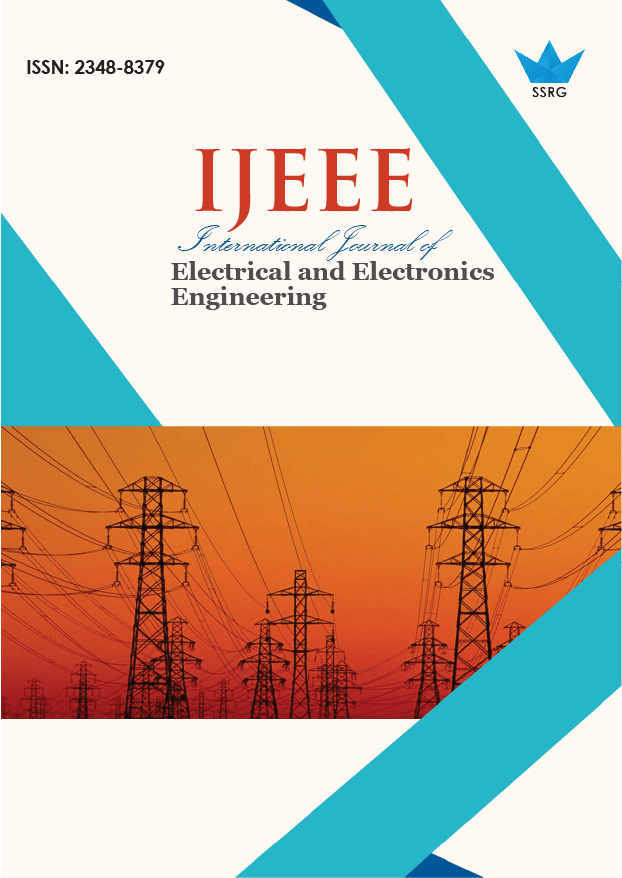Trajectory Control for Mobile Robot by Sliding Mode

| International Journal of Electrical and Electronics Engineering |
| © 2025 by SSRG - IJEEE Journal |
| Volume 12 Issue 1 |
| Year of Publication : 2025 |
| Authors : Sebti Berrahal, Abdesslem Chikhi, Laid Khettache |
How to Cite?
Sebti Berrahal, Abdesslem Chikhi, Laid Khettache, "Trajectory Control for Mobile Robot by Sliding Mode," SSRG International Journal of Electrical and Electronics Engineering, vol. 12, no. 1, pp. 222-229, 2025. Crossref, https://doi.org/10.14445/23488379/IJEEE-V12I1P122
Abstract:
This study presents a sliding mode control method for wheeled mobile robots designed to enhance trajectory tracking accuracy and robustness. The method begins with the formulation of constraint and dynamic equations that describe the robot's motion, accounting for the complex interactions between the wheels and the ground and the forces and moments that influence its movement. A comprehensive state model of the system is developed to enhance understanding of the robot's internal and external dynamics. A variable structure controller based on sliding mode principles is employed to achieve effective control, which is particularly advantageous for systems encountering uncertainties and disturbances, ensuring stability amid parameter variations. Specific modifications are applied to address the issue of chattering -rapid oscillations that can compromise precision and durability. Advanced techniques, such as saturation functions and higher-order sliding modes, are utilized to mitigate these oscillations while preserving the robustness of the control system. Finally, numerical simulations are performed to evaluate the performance of the proposed method under diverse conditions. The results illustrate that the controller facilitates precise trajectory tracking, even in the presence of external disturbances and dynamic uncertainties, confirming the effectiveness of sliding mode control for wheeled mobile robots in achieving stability, rapid convergence to target trajectories, and reduced chattering effects.
Keywords:
Sliding mode, Lagrange formalism, Non-holonomic mobile robot, Trajectory pursuit.
References:
[1] Bruno Siciliano, and Oussama Khatib, Springer Handbook of Robotics, 2nd ed., Springer, 2016.
[Publisher Link]
[2] Roland Siegwart, Illah Reza Nourbakhsh, and Davide Scaramuzza, Introduction to Autonomous Mobile Robots, MIT Press, 2011.
[Google Scholar]
[3] G.A. Bekey, Autonomous Robots: from Biological Inspiration to Implementation and Control, MIT Press, 2005.
[Google Scholar]
[4] Marko Bjelonic et al., “Rolling in the Deep–Hybrid Locomotion for Wheeled-Legged Robots Using Online Trajectory Optimization,” IEEE Robotics and Automation Letters, vol. 5, no. 2, pp. 3626-3633, 2020.
[CrossRef] [Google Scholar] [Publisher Link]
[5] Vadim I. Utkinm, “Scope of the Theory of Sliding Modes,” Sliding Modes in Control and Optimization, pp. 1-11, 1992.
[CrossRef] [Google Scholar] [Publisher Link]
[6] Yuri Shtessel et al., Sliding Mode Control and Observation, Control Engineering, Birkhäuser New York, 2015.
[CrossRef] [Google Scholar] [Publisher Link]
[7] Tinh Nguyen et al., “Neural Network-Based Adaptive Sliding Mode Control Method for Tracking of A Nonholonomic Wheeled Mobile Robot with Unknown Wheel Slips, Model Uncertainties, and Unknown Bounded External Disturbances,” Acta Polytechnica Hungarica, vol. 15, no. 2, pp. 103-123, 2018.
[Google Scholar] [Publisher Link]
[8] Zhongchao Liang et al., “Torque Vectoring and Rear-Wheel-Steering Control for Vehicle's Uncertain Slips on Soft and Slope Terrain Using Sliding Mode Algorithm,” IEEE Transactions on Vehicular Technology, vol. 69, no. 4, pp. 3805-3815, 2020.
[CrossRef] [Google Scholar] [Publisher Link]
[9] Valentin Falkenhahn et al., “Dynamic Modeling of Bellows-Actuated Continuum Robots Using the Euler–Lagrange Formalism,” IEEE Transactions on Robotics, vol. 31, no. 6, pp. 1483-1496, 2015.
[CrossRef] [Google Scholar] [Publisher Link]
[10] Zhou Zhou, and Clement Gosselin, “Simplified Inverse Dynamic Models of Parallel Robots Based on a Lagrangian Approach,” Meccanica, vol. 59, pp. 657-680, 2024.
[CrossRef] [Google Scholar] [Publisher Link]
[11] J.Y. Hung, W. Gao, and J.C. Hung, “Variable Structure Control: A Survey,” IEEE Transactions on Industrial Electronics, vol. 40, no. 1, pp. 2-22, 1993.
[CrossRef] [Google Scholar] [Publisher Link]
[12] Hyun-Sik Shim, Jong-Hwan Kim, and Kwangill Koh, “Variable Structure Control of Nonholonomic Wheeled Mobile Robot,” Proceedings of 1995 IEEE International Conference on Robotics and Automation, Nagoya, Japan, vol. 2, pp. 1694-1699, 1995.
[CrossRef] [Google Scholar] [Publisher Link]
[13] Niraj Kumar Goswami, and Prabin Kumar Padhy, “Sliding Mode Controller Design for Trajectory Tracking of a Non-Holonomic Mobile Robot with Disturbance,” Computers & Electrical Engineering, vol. 72, pp. 307-323, 2018.
[CrossRef] [Google Scholar] [Publisher Link]
[14] Shibly Ahmad Al-Samarrai et al., “Robust Adaptive Sliding Mode Controllers Design for a Non-Holonomic Mobile Robot,” Mobile Robot: Motion Control and Path Planning, pp. 489-556, 2023.
[CrossRef] [Google Scholar] [Publisher Link]
[15] Hai Huang et al., “Vehicle-Manipulator System Dynamic Modeling and Control for Underwater Autonomous Manipulation,” Multibody System Dynamics, vol. 41, pp. 125-147, 2017.
[CrossRef] [Google Scholar] [Publisher Link]

 10.14445/23488379/IJEEE-V12I1P122
10.14445/23488379/IJEEE-V12I1P122